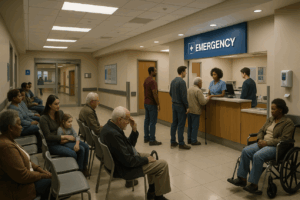Case Study: Triage Errors in the Emergency Department
When patients arrive at an emergency department (ED), they rely on trained medical professionals to quickly assess the urgency of their condition. This initial assessment process—triage—determines how soon a patient will be evaluated and treated. But when triage errors occur, the consequences can be catastrophic.
At Hoffer & Sheremet, PLC, we have seen firsthand how misclassification, delay, and miscommunication during triage can lead to permanent injury or even death. Understanding how triage works, why errors happen, and how the law addresses them is critical for anyone who has suffered harm in an emergency room setting.
What Is Triage in the Emergency Department?
Triage is the system emergency departments use to prioritize patients based on the severity of their condition, not the order in which they arrive. Most hospitals use the Emergency Severity Index (ESI) or a similar system to categorize patients from Level 1 (most urgent) to Level 5 (least urgent).
-
Level 1: Immediate life-saving intervention required (e.g., cardiac arrest)
-
Level 2: High-risk situation needing prompt attention (e.g., stroke symptoms)
-
Level 3: Urgent but stable conditions (e.g., moderate asthma attack)
-
Level 4–5: Non-urgent issues (e.g., minor injuries)
When triage is done correctly, critically ill patients receive rapid evaluation and treatment. But when done incorrectly, the delay can mean the difference between recovery and irreversible damage.
Emergency_Severity_Index_Handbook.pdf

Common Causes of Triage Errors
Research has shown that 34% of patients are mis-triaged. Luckily, most mistakes are in over-triaging patient (i.e., assigning a more urgent level) than under-triaging. Over-triaging causes additional resources to be used, but generally will not result in patient harm.
Under-triaging can lead to delay in care that can harm patients. Triage mistakes often occur due to:
-
Failure to recognize life-threatening symptoms (e.g., chest pain mistaken for anxiety)
-
Underestimating severity because of incomplete history-taking
-
Bias or assumptions about a patient’s age, gender, race, or demeanor
-
Overcrowded emergency rooms and understaffing
-
Inadequate training or protocol deviations
-
Communication breakdowns between triage staff and treating providers
Consequences of Triage Errors
Triage errors can result in delayed diagnosis and delayed treatment, which may lead to:
-
Worsening of condition (e.g., stroke progressing from mild to disabling)
-
Preventable complications (e.g., sepsis becoming life-threatening)
-
Permanent disability (e.g., paralysis from spinal cord injury)
From a legal perspective, the key question is whether the triage nurse or other medical staff failed to meet the standard of care and whether that failure caused harm to the patient.
Proving Triage Error in a Medical Malpractice Case
To succeed in a triage error case, a plaintiff must prove:
-
Duty of Care: The hospital and triage staff owed the patient a duty to follow accepted emergency care standards.
-
Breach: The staff failed to recognize or properly prioritize the patient’s symptoms.
-
Causation: The delay in treatment caused by the triage error directly led to harm.
-
Damages: The patient suffered measurable harm, such as medical expenses, lost income, or permanent disability.
Expert testimony from emergency medicine physicians and triage nurses is often essential to explain how the error occurred and why the injury or death was preventable.
Real-Life Case Example: Heart Attack Misclassified as Acid Reflux
A 56-year-old man walked into a Michigan emergency department complaining of chest discomfort, shortness of breath, and nausea. He told the triage nurse that the pain radiated to his left arm and jaw—classic warning signs of a heart attack.
The triage nurse, busy with a packed waiting room, attributed his symptoms to possible acid reflux and assigned him an ESI Level 4. This meant he would be seen only after patients with more urgent classifications.
Over the next 90 minutes, he sat in the waiting room as his condition worsened. Eventually, he collapsed. Resuscitation efforts revealed that he was in cardiac arrest caused by a massive heart attack (STEMI). Although doctors restored his heartbeat, the prolonged delay meant a significant portion of his heart muscle had been irreversibly damaged. He now suffers from chronic heart failure and cannot work.
The malpractice investigation found that triage protocols require immediate EKG and physician evaluation for chest pain with cardiac risk factors. Had he been classified as an ESI Level 2 or 1, he would have received clot-busting medication or emergency catheterization before his heart stopped. The hospital settled the case, acknowledging that the triage error caused permanent, preventable harm.
Your Rights After a Triage Error in Michigan
If you believe you or a loved one were harmed due to a triage error, you have legal rights. In Michigan, medical malpractice cases must generally be initiated by sending a Notice of Intent within two years of the error, though exceptions apply for delayed discovery.
Contact Hoffer & Sheremet, PLC
Triage errors can have life-altering consequences. At Hoffer & Sheremet, PLC, we hold hospitals accountable when patients suffer harm from delayed or improper emergency care.
Call us today at (616) 278-0888 or contact us online for a free consultation. We’ll evaluate your case, explain your options, and fight for the justice you deserve.